How to Make a Drone / UAV - Lesson 1: Terminology
How to Make a Drone / UAV - Lesson 2: The Frame
How to Make a Drone / UAV - Lesson 3: Propulsion
How to Make a Drone / UAV - Lesson 4: Choose a flight controller
How to Make a Drone / UAV - Lesson 5: Assembly
How to Make a Drone / UAV - Lesson 6: Get it all working together
How to Make a Drone / UAV - Lesson 7: FPV & Long-range
How to Make a Drone / UAV - Lesson 8: Aircraft
Now that you have decided to create your own custom or semi-custom multirotor UAV, the first step is to choose the frame. You can either create your own, or base the project off a UAV frame kit. There are many different types of frames and configurations used to create multi-rotor UAVs. This guide covers the common / basic frame types, materials used to construct the frame, as well as design considerations. We welcome any feedback you have in the comments section below.
Tricopter
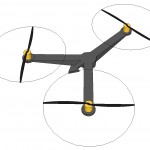 Tricopter Tricopter
|
-
Description: A UAV which has three arms, each connected to one motor. The front of the UAV tends to be between two of the arms (Y3). The angle between the arms can vary, but tends to be 120 degrees. In order to move, the rear motor normally needs to be able to rotate (using a normal RC servo motor) in order to counteract the gyroscopic effect of an uneven number of rotors, as well as to change the yaw angle. A Y4 is slightly different in that it uses two motors mounted on the rear arm, which takes care of any gyroscopic effects - no servo is therefore needed.
-
Advantages: Different "look" for a UAV. Flies more like an airplane in forward motion. Price is theoretically lowest among those described here since it uses the fewest number of brushless motor (and ESC).
-
Disadvantages: Since the copter is not symmetric, the design uses a normal RC servo to rotate the rear motor and as such, the design is less straightforward than many other multi-rotors. The rear arm is more complex since a servo needs to be mounted along the axis. Most, though not all flight controllers support this configuration.
|
Quadcopter
 Quadcopter Quadcopter
|
-
Description: A "quadcopter" drone which has four arms, each connected to one motor. The front of the UAV tends to be between two arms (x configuration), but can also be along an arm (+ configuration).
-
Advantages: Most popular multi-rotor design, simplest construction and quite versatile. In the standard configuration, the arms / motors are symmetric about two axes. All flight controllers on the market can work with this multirotor design.
-
Disadvantages: There is no redundancy, so if there is a failure anywhere in the system, especially a motor or propeller, the craft is likely going to crash.
|
Hexacopter
 Hexacopter Hexacopter
|
-
Description: A "hexacopter" has six arms, each connected to one motor. The front of the UAV tends to be between two arms, but can also be along one arm.
-
Advantages: It is easy to add two additional arms and motors to a quadcopter design; this increases the total thrust available, meaning the copter can lift more payload. Also, should a motor fail, there is still a chance the copter can land rather than crash. Hexacopters often use the same motor and support arm, making the system "modular". Almost all flight controllers support this configuration.
-
Disadvantages: This design uses additional parts, so compared to a quadcopter which uses a minimum number of parts, the equivalent hexacopter using the same motors and propellers would be more expensive and larger. These additional motors and parts add weight to the copter, so in order to get the same flight time as a quadcopter, the battery needs to be larger (higher capacity) as well.
|
Y6
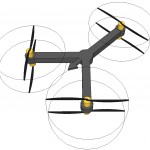 Y6 Hexacopter Y6 Hexacopter
|
-
Description: A Y6 design is a type of hexacopter but rather than six arms, it has three support arms, with a motor connected to either side of the arm (for a total of six motors). Note that the propellers mounted to the underside still project the thrust downward.
-
Advantages: A Y6 design actually eliminates a support arm (as compared to a quadcopter), for a total of three. This means the copter can lift more payload as compared to a quadcopter, with fewer components than a normal hexacopter. A Y6 does not have the same issue as a Y3 as it eliminates the gyro effect using counter-rotating propellers. Also, should a motor fail, there is still a chance the copter can land rather than crash.
-
Disadvantages: This uses additional parts, so compared to a quadcopter which uses the same components, the equivalent hexacopter would be more expensive. Additional motors and parts add weigh to the copter, so in order to get the same flight time as a quadcopter, the battery needs to be larger (higher capacity) as well. The thrust obtained in a Y6 as opposed to normal hexacopter is slightly lower (based on experience), likely because the thrust from the top propeller is affected by the lower propeller. Not all flight controllers support this configuration.
|
Octocopter
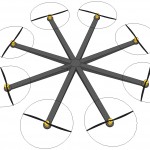 Octocopter Octocopter
|
-
Description: An octocopter has eight arms, each connected to one motor. The front of the UAV tends to be between two arms.
-
Advantages: More motors = more thrust, as well as increased redundancy.
-
Disadvantages: More motors = higher price and larger battery pack. When you reach this level. most users are looking at very heavy payloads such as DSLR cameras and heavy gimbal systems. Given the price of these systems, added redundancy is really important.
|
X8
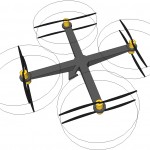 X8 Octocopter X8 Octocopter
|
-
Description: An X8 design is still an octocopter, but has four support arms, each with a motor connected to either side of each arm, for a total of 8 motors.
-
Advantages: More motors = more thrust, as well as increased redundancy. Rather than using fewer yet more powerful motors, octocopters provide added redundancy in the event of a motor failure.
-
Disadvantages: More motors = higher price and larger battery pack. When you reach this level. most users are looking at very heavy payloads such as DSLR cameras and heavy gimbal systems.
|
UAV Size
UAVs come in a variety of different sizes, from "nano" which are smaller than the palm of your hand, to mega, which can only be transported in the bed of a truck. Although both very large and very small UAVs may get quite a bit of attention, they are not necessarily the most practical for hobbyists. For most users who are getting started in the field, a good size range which offers the most versatility and value is between 350mm to 700mm. This measurement represents the diameter of the largest circle which intersects all of the motors. Not only do parts for UAVs in this size range come in a variety of different prices, there is by far the greatest selection of products available.
 Drone Sizes
Drone Sizes
Smaller UAVs are not necessarily less expensive than medium sized ones. This is largely due to the fact that the technology and time needed to produce small brushless motors or small brushless motor controllers is the same for small parts or for large ones. The prices for the additional electronics such as the flight controller, remote control, camera etc. tend not to change at all. The frame is normally one of the least expensive parts of a UAV, so although the frame for a small UAV may be half the price of a larger one, the overall price, with all parts needed, may still be very close.
UAV Materials / Construction
Below are the more common materials found in multi-rotor drones. This list does not include all possible materials which can be used and should be looked at as a guideline / opinion as to the use of each material to make the frame of a drone. Ideally the frame should be rigid with as minimal vibration transmission as possible.
Wood
If you want your frame to be as inexpensive as possible, wood is a great option, and will greatly reduce build time and additional parts required. Wood is fairly rigid and has been a proven material time and time again. Although the aesthetics may suffer, replacing a broken arm after a crash is relatively easy and "dirt cheap". Painting the arm helps hide the fact that it's wood. Ensure you use wood which is straight (no twisting or warping). |
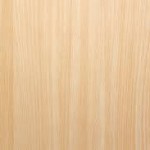 |
Foam
Foam is rarely used as the sole material for the frame and there tends to be some form of inner skeleton or reinforcement structure. Foam can also be used strategically; as propeller guards, landing gear or even as dampening. There are also many different types of foam, and some variations are considerably stronger than others. Experimentation would be needed. |
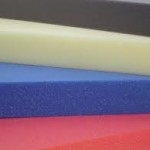 |
Plastic
Most users can only access and work with plastic sheets (rather than 3D plastic shapes or objects). Plastic tends to flex and as such is not ideal. Used strategically (such as a cover or landing gear), plastic can be a great option. If you are considering 3D printing the frame, consider the time needed to print the part (versus buying a plastic frame kit), and how rigid the part will be in the air. 3D printing parts (or the entire frame) has so far been more successful on smaller quadcopters. Using plastic extrusions may also be an option for small and medium sized drones. |
 |
Aluminum
Aluminum comes in a variety of shapes and sizes; you can use sheet aluminum for body plates, or extruded aluminum for the support arms. Aluminum may not be as lightweight as carbon fiber or G10, but the price and durability can be quite attractive. Rather than cracking, aluminum tends to flex. Working with aluminum really only requires a saw and a drill; take the time to find the right cross section (lightweight and strong), and try to cut out any non-essential material. |
 |
G10
G10 (variation of fiberglass) is used as a less expensive option than carbon fiber, though the look and basic properties are almost identical. G10 is mostly available in sheet format and is used largely for top and bottom plates, while tubing in carbon fiber (as compared to G10) is usually not much more expensive and is often used for the arms. Unlike Carbon Fiber, G10 does not block RF signals. |
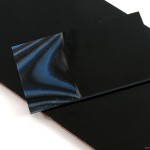 |
PCB
Printed Circuit Boards are essentially the same as fiberglass, but unlike Fiberglass, PCBs are always flat. Frames <600mm sometimes use PCB material for top and bottom plates, since the electrical connections integrated into the PCB can reduce parts (for example the power distribution board is often integrated into the bottom plate). Small quadcopter frames can be made entirely out of a single PCB and integrate all of the electronics. |
 |
Carbon Fiber
Carbon fiber is still the #1 sought-after building material due to its light weight and high strength. The process to manufacturer carbon fiber is still quite manual, meaning normally only straightforward shapes such as flat sheets and tubes are mass produced, while more complex 3D shapes are normally "one off". Carbon fiber impedes RF signals, so be sure to take this into consideration when mounting electronics (especially antennas). |
 |
Additional Considerations
Gimbal
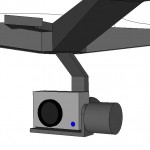 Gimbal Gimbal
|
A gimbal is often used to stabilize a camera (for FPV or video). Connecting a camera directly to a UAVs frame means it is always pointing in the same direction as the frame itself, which does not provide the best video experience. Most gimbals are mounted beneath the frame, in line with the UAV's center of weight. Gimbals are either connected directly to the bottom of a UAV, or to a rail system. The gimbal system therefore means the UAV needs longer landing gear so it does not touch the ground. Mounting the gimbal or camera to the front of the UAV can also be done, and the weight can be offset by placing the main battery further aft in the aircraft. |
Payload
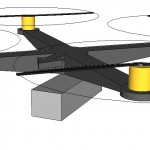 Payload Payload
|
Adding a "transportation" payload to a drone is still a bit of a luxury, as any added weight reduces flight time and reduces the other items you may wish to add as part of the key features. If you really plan to have a payload, ensure that the mounting is as lightweight as possible (while still being secure) and that the load itself does not shift in flight. |
Landing Gear
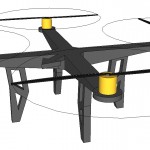 Landing Gear Landing Gear
|
Landing gear for a UAV helps in many ways, and although some drones land directly on their bottom plate (normally to save weight), using landing gear cane be beneficial in many ways:
- Providing clearance between the bottom of the UAV and a non-flat surface such as grass (or small rocks)
- Providing clearance between the battery pack / gimbal and the ground
- In the event of a hard landing, it's ideally the landing gear which will break (and be replaced) rather than the frame
- The right landing gear can also provide flotation (lightweight pool noodles etc.)
|
Mounting
 Mounting Considerations Mounting Considerations
|
Although a UAV is far simpler to design and build than a normal helicopter, there are still enough parts to think about, and how to mount them should be considered early in the design process. Some general points to consider regarding mounting, based largely on experience, include:
- If you plan to create a custom frame, one of the more difficult mounting areas is between the motors and the frame, as the four mounting holes need to be placed / drilled precisely. Most motors for 400-600mm frames have the same mounting hole pattern, making it possible to use a frame from one manufacturer, and the motors from another.
- The placement of all additional components should ideally be symmetric about one axis, which helps facilitate locating and adjusting the aircraft's center of mass.
- The flight controller should ideally be located at the center of the circle connecting all motors (and as such at the center of mass).
- The flight controller is normally fixed to the frame using standoffs, rubber dampeners or double-sided tape. Many companies seem to use similar mounting hole locations for the flight controller (ex 35mm or 45mm square), but there is no "industry standard".
- The battery is heavy enough such that if your center of mass if off by a bit, you can move the battery slightly to adjust it. Ensure the battery's mounting has a bit of "play", but still ensures it holds the battery firmly. Velcro straps are often used to secure the battery, and consider adding adhesive-backed velcro to the battery and frame as well.
|
Guidelines
Step 1: See what materials and machining processes you have at your disposal.
- If you do not have much as far as machining capabilities, are not comfortable with tools, or simply want a more professional frame, then consider purchasing a frame kit
- A decent frame can be made with basic tools and materials, but determining areas where it may be structurally weak, resonate (cause vibration) or may be misaligned take a keen eye and experience
- If you plan to create a custom frame, take into consideration all of the mounting which needs to be done; motors, electronics etc. and plan accordingly.
Step 2: List all of the additional (non-essential) parts you plan to add
- Additional items might include: one, two or three axis camera gimbal, parachute, onboard mini computer, payload, long-range electronics (tend to be larger / heavier), floatation etc.
- This list of additional / non-essential parts will give you an idea of the size of drone you will need, and add to the total weight calculation (to be done later)
Step 3: Get a rough idea of the size of frame you want
- A larger frame does not necessarily make the drone more capable, and a smaller frame does not mean the drone will be any less expensive
- A drone between 400 and 600mm is suggested for beginners
Step 4: Design, build and test the frame
- If you opted to purchase a frame kit, you should not have much to worry about in regards to durability / rigidity / assembly
- If you chose instead to design and build your own frame, it's important to test its durability, check the weight and see if it can withstand vibration (minimal flex)
- Consider using a CAD software (many are free such as Google Sketchup) to design the frame and ensure dimensions are correct
Now that you have your frame, you can proceed with the next lesson.
This is a companion discussion topic for the original entry at https://community.robotshop.com/tutorials/show/how-to-make-a-drone-uav-lesson-2-the-frame



















